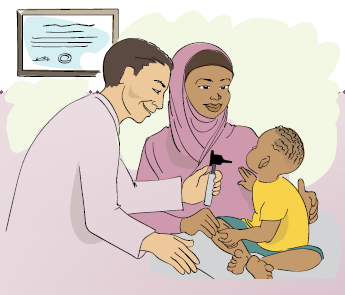Race and Diversity: 5 Tips to Talk to Children Early and 5 Books to Start the Conversation
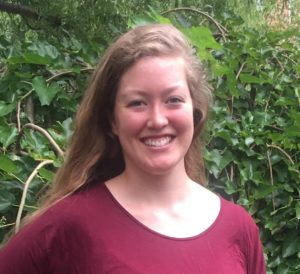 Did You Know: The ability to discriminate visually based on race emerges early in infancy: 3-month-olds can perceptually differentiate faces by race and 6-month-olds can perceptually categorize faces by race, according to a study funded by the Eunice Kennedy Shriver National Institute of Child Health and Human Development.
Did You Know: The ability to discriminate visually based on race emerges early in infancy: 3-month-olds can perceptually differentiate faces by race and 6-month-olds can perceptually categorize faces by race, according to a study funded by the Eunice Kennedy Shriver National Institute of Child Health and Human Development.
Now, more than ever, current events and research show how important it is to talk to children about race and diversity as early as possible. The question is: how should parents and families start the conversation?
As a white woman married to a Black man with a biracial 1-year-old, I have grappled with this question for years. Children’s books written by Black, Indigenous, and People of Color (BIPOC) authors with strong, relatable BIPOC characters are a great way to start the conversation about race and diversity.
Depending on your experiences with race, how and where you grew up, and your interactions with people from different cultures, this conversation might be uncomfortable. Just keep in mind that it’s critical for parents to “confront their own biases so that their example is consistent with messages of racial and ethnic tolerance,” said Ashaunta Anderson, MD, MPH, MSHS, FAAP and Jacqueline Dougé, MD, MPH, FAAP in an American Academy of Pediatrics article.
“Identify and correct your own racially biased thoughts, feelings, and actions. If you want your children to believe what you preach, you have to exhibit those behaviors as well,” the authors added. “Your everyday comments and actions will say more than anything else.”
Below are five tips to start the conversation about race and diversity with children and five of my favorite board books written by BIPOC authors featuring relatable BIPOC characters.
Tips to start the conversation about race and diversity with children:
- Start the conversation about race and diversity early. Begin at birth!
- Talk about how specific skin colors have originated from different places in the world.
- Look for books and art that are written by and represent BIPOCs.
- Select books that show fairness, empathy, and kindness.
- Choose books that show diverse families having positive experiences.
Recommend Books To Discuss Race and Diversity with Children:
1. Baby Says by John Steptoe
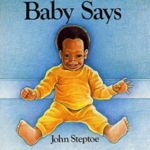 Written over 30 years ago, Steptoe tells the story of a baby and his older brother. The older brother’s kindness and patience are beautiful to observe as the baby throws a teddy bear at his block tower. To engage young children, try using blocks to build the older brother’s tower as inspiration.
Written over 30 years ago, Steptoe tells the story of a baby and his older brother. The older brother’s kindness and patience are beautiful to observe as the baby throws a teddy bear at his block tower. To engage young children, try using blocks to build the older brother’s tower as inspiration.
2. Hey, Baby: A Baby’s Day in Doodles by Andrea Pippins
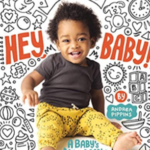 Follow baby throughout his joyous day. This adorable look at babyhood appeals to new parents and grandparents who will recognize their own little ones in the pages. Read this book throughout the day with children to show baby is just like YOU!
Follow baby throughout his joyous day. This adorable look at babyhood appeals to new parents and grandparents who will recognize their own little ones in the pages. Read this book throughout the day with children to show baby is just like YOU!
3. Woke Baby by Mahogany L. Browne
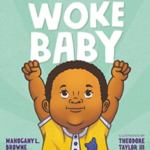 If you haven’t heard the phrase “stay woke,” it essentially means to be aware of the issues facing our nation, such as inequality and systematic racism. “Woke” babies cry out for justice. In this book, the baby rests only a bit because there’s so much work to be done.
If you haven’t heard the phrase “stay woke,” it essentially means to be aware of the issues facing our nation, such as inequality and systematic racism. “Woke” babies cry out for justice. In this book, the baby rests only a bit because there’s so much work to be done.
4. Dream Big Little One by Vashti Harrison
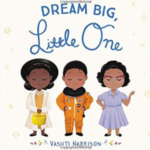 In this book, Harrison highlights the many accomplishments of Black women, such as Mae Jemison, Maya Angelou, Florence Joyner, Oprah Winfrey, and Julie Dash. To help your little one connect to these women, try finding toys around the house that relate to their accomplishments. For example, we built a rocket ship block tower for Mae Jemison to get to outer space!
In this book, Harrison highlights the many accomplishments of Black women, such as Mae Jemison, Maya Angelou, Florence Joyner, Oprah Winfrey, and Julie Dash. To help your little one connect to these women, try finding toys around the house that relate to their accomplishments. For example, we built a rocket ship block tower for Mae Jemison to get to outer space!
5. Whose Toes are Those by Jabari Asim
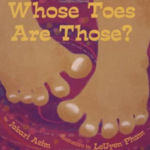 A variation of the classic, “This Little Piggy Went to Market,” chant makes this book interactive for young children. Create your own chant for the other five toes to engage your little one.
A variation of the classic, “This Little Piggy Went to Market,” chant makes this book interactive for young children. Create your own chant for the other five toes to engage your little one.
.



